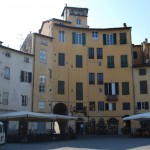LUCCA (ITALY)
Exquisite, filled with quietness, surrounded by ancient walls, the city consists of pleasant mosaic of traditional squares, tiny churches, museums, galleries and cobble-stone streets. The capital of Lucca province, the city of Lucca (86 thousand people) is a cultural and historical center. Clear cut design of the streets of Lucca has been left intact from the time of ancient Romans, who founded their settlement here in 180 B.C. Lucca’s original purpose was to defend the surrounding territories, over which Ligures and Romans conflicted with each other; that is why the city walls were so quickly erected.
Under Goths and Lombards Lucca was the capital of Tuscany, which reached its flourishing because of silk trade –– manufacture and trade of linen underwear is still the main source of the city dweller’s income. In XIV century Lucca conquered Pisa and Pistoia and came close to conquering Florence. After that a period of recession started, even though Lucca preserved its independence until Napoleon’s time. Prior to the uniting of Italy, the Bourbons remained in power in Lucca.
Today all the main sights of interest in Luca are within the city walls. Mighty fortress walls erected in XVI and XVII centuries frustrate the traffic in the city but tourists have a wonderful opportunity to get acquainted with the city walking around its entire territory. Eleven bastions of different shapes and sizes are located along the perimeter of the wall. Two of them Torrione del Bastardo and San Martino, preserved to this day in the shape they were built in XVII century. San Martino Bastion is open for tourists, and one can examine this impressive construction particularly in detail. San Paulino Bastion, fully restored and open for excursions, presents an unusual and successful decision of using basement facilities. Porta San Pietra (1565-1566), the oldest of all three city gates, were the only ones, through which foreigners were allowed to enter Lucca. Its peculiar characteristic was an open space behind the walls that remains there to this day; it left no chances for enemies to hide.
Just like all Roman cities of that time, Lucca was built according to a design of all the space of the city being divided by perpendicular streets called Cardo and Decumanus into square blocks. During excavations, sections of ancient paving preserved under the ground were found, which allowed reconstructing the original design of the ancient city. Walking on Lucca’s quiet streets stretching between medieval houses, one can see squares, churches and other monuments including an ancient Roman amphitheater – an evidence of the city’s centuries-long history. Throughout the ages the stones, of which the ancient Roman amphitheater was built, were dissembled and used for erection of churches and palaces. Today the little that remained of the amphitheater can be seen on Piazza del Mercato round square. Medieval buildings outline the shape of the ancient Roman amphitheater. Low arched passes on the square indicate where the gates were, through which beasts and gladiators came out to the arena. The square is surrounded by a solid ring of buildings, and one can access it only through four pedestrian entrances.
Pages: 1 2

